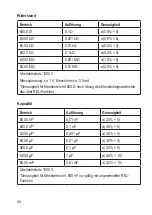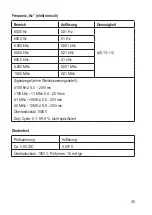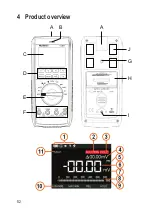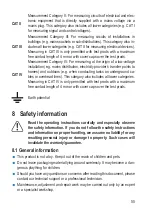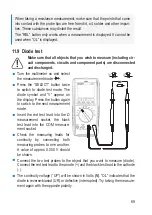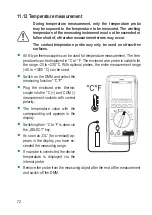
57
8.4 Operation
Consult an expert when in doubt about the operation, safety or connection of
the device.
For installations in industrial facilities, follow the accident prevention regulations
for electrical systems and equipment issued by the national safety organisation
or the corresponding national authority.
In schools, educational facilities, and hobby and DIY workshops, meters must
be used under the responsible supervision of qualified personnel. The same
applies when the meter is used by people with reduced physical and mental
capabilities.
Always ensure that the multimeter is set to the correct measurement mode be-
fore taking a measurement.
Always remove the test probes from the measured object before changing the
measurement range.
Check the multimeter and test leads for signs of damage before each measure-
ment. Never take measurements if the protective insulation is damaged (torn,
missing, etc.). The test leads come with a wear indicator. The second layer of
insulation will become visible if the lead is damaged (the second layer of in-
sulation is a different colour). If this occurs, discontinue use and replace the
measurement accessory.
The voltage between the multimeter connection points and the earth must not
exceed 1000 V DC/AC in CAT III or 600 V DC/AC in CAT IV.
Exercise particular caution when working with voltages higher than 33 V (AC)
and 70 V (DC)! Touching electrical conductors with these voltages may cause
a fatal electric shock.
When using test probes without protective caps, meas-
urements between the multimeter and the earth poten-
tial must not exceed the CAT II measurement category.
When taking CAT III measurements, the protective
caps must be placed on the probe tips (max. length
of exposed contacts = 4 mm) to avoid accidental short
circuits. These are supplied with the device and pre-mounted on the test probes.


